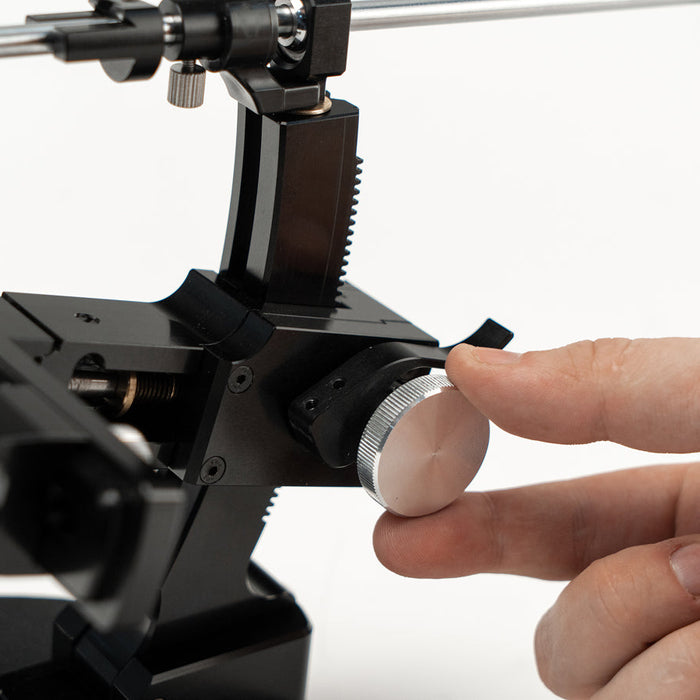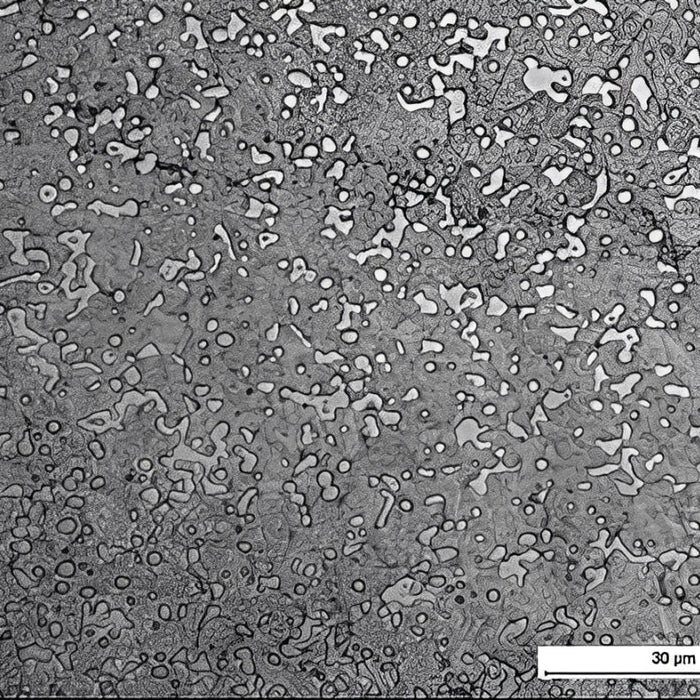Why people favor Elmax steel on their knives?
Elmax is a stainless steel that’s earned a loyal following among knife makers and collectors for a simple reason — it performs well across the board. Produced by Böhler-Uddeholm using powder metallurgy, it strikes a rare balance of edge retention, corrosion resistance, and toughness.
Most steels lean one way or the other: tough but quick to rust, or highly stainless yet brittle. Elmax somehow threads the needle. You’ll find it in everything from everyday carry (EDC) folders to outdoor fixed blades and custom showpieces. It’s the sort of steel that feels overbuilt until you actually use it in the field. The only real downsides? Cost, and the patience required to sharpen it properly. That hardness that keeps an edge forever also laughs at cheap pull-through sharpeners — you’ll need diamond stones or a guided system if you want to do it justice.
Who makes Elmax steel, and where did it come from?
The story begins with Böhler-Uddeholm, an Austrian-Swedish company known for its high-end tool steels and metallurgy research. In the early 2000s they launched a line of “super-clean” stainless steels made through powder metallurgy, and Elmax quickly stood out.
Originally designed for demanding industrial tools, molds, and even surgical instruments, it soon caught the attention of knife manufacturers such as Zero Tolerance and LionSteel, as well as independent custom makers. What drew them in was its ability to hold an edge through long, hard use without catastrophic chipping — a common failure in high-hardness steels. The trade-off, of course, is price. Producing powder-metallurgy steels requires advanced equipment and fine-tuned control, so an Elmax blade typically costs more than one made from conventional alloys like AUS-8 or 440C. Still, most users who’ve owned one will tell you the performance difference is obvious.
What is the chemical composition of Elmax steel?
Elmax contains roughly 1.7 % carbon, 18 % chromium, 3 % vanadium, and 0.8 % molybdenum. Each element serves a purpose: carbon gives the steel its hardness and edge-holding ability; chromium builds the stainless barrier against rust; vanadium forms tiny hard carbides that fight wear and stabilize a fine grain; molybdenum contributes to overall strength and toughness.
This chemistry puts Elmax firmly in the “super-steel” class. The magic happens when these ingredients are atomized and blended under the powder-metallurgy process, which yields a remarkably uniform structure — no large carbides waiting to crack under pressure. The trade-off is complexity and cost: producing steel this way takes far more effort than melting a traditional ingot, but the reward is consistent, high-grade performance that knife makers can rely on.
|
Element
|
Approx. %
|
Primary Role
|
|
Carbon (C)
|
1.7
|
Hardness, edge retention
|
|
Chromium (Cr)
|
18
|
Corrosion resistance, hardness
|
|
Vanadium (V)
|
3
|
Wear resistance, grain refinement
|
|
Molybdenum (Mo)
|
0.8
|
Toughness, strength
|
Is Elmax steel stainless?
Yes — thanks to its roughly 18 % chromium, Elmax qualifies as stainless steel. In everyday use that means you can take it camping, use it in the kitchen, or carry it in your pocket without worrying about rust spots showing up overnight.
Still, “stainless” doesn’t mean “invincible.” Saltwater, blood, and citrus will eventually leave marks if you ignore the blade. Wipe it off, dry it, and a drop of oil now and then will keep it spotless. Compared with semi-stainless tool steels like D2, Elmax shrugs off humidity far better, making it a smart choice for humid climates or anyone who sweats a lot while working with a knife. The trade-off is the cost of those extra alloying elements and the tighter heat-treat window required to bring out their best. In short: it’s easy to live with, but it still appreciates a bit of attention.
How hard is Elmax steel on the Rockwell scale?
Properly treated, Elmax usually measures 59 – 62 HRC on the Rockwell hardness scale. That’s the sweet zone where knives feel crisp on a cut yet don’t crumble if they meet something tougher than expected.
Most makers aim for about 60 HRC, a middle ground that keeps a razor edge while allowing some flex before the edge chips. Push the hardness higher and you gain longer edge life—but at the cost of resilience; dial it lower and sharpening becomes easier but you’ll resharpen more often.
Knife enthusiasts who sharpen by hand often describe Elmax as “patient” steel: slow to grind, but it rewards good technique with a clean, refined edge. If you’re using simple stones, expect a workout. A guided sharpener—TSPROF systems are a favorite—takes the guesswork out and saves both time and frustration.
How does Elmax compare to M390 and S35VN?
Elmax competes directly with Böhler M390 and Crucible S35VN, two steels that often appear in the same premium tier. Here’s the quick comparison, rated from 1 to 10 based on typical lab and field performance:
|
Property
|
Elmax
|
M390
|
S35VN
|
|
Edge Retention
|
9
|
10
|
7
|
|
Corrosion Resistance
|
9
|
10
|
7
|
|
Toughness
|
8.5
|
8
|
7
|
|
Ease of Sharpening
|
6
|
4
|
8
|
|
Price Tier (↑ = costlier)
|
8 – 9
|
10
|
7
|
Elmax vs M390: M390 holds a marginally longer-lasting edge and fends off rust a bit better, but it’s a bear to sharpen and slightly less forgiving if you strike something hard. Elmax sacrifices a touch of ultimate wear resistance in exchange for more toughness—useful if your knife sees wood, bone, or occasional abuse.
Elmax vs S35VN: S35VN is the friendliest to sharpen and costs less, yet it can’t match Elmax’s staying power or stainlessness. Many users notice that S35VN loses its hair-shaving bite sooner, though a few quick passes on a ceramic rod bring it back easily.
So the real decision isn’t which is “best,” but what kind of trade-off you prefer. Elmax sits comfortably in the middle—strong, resilient, and relatively low-maintenance—if you’re willing to pay a bit more and invest in proper sharpening tools.
What are the main applications of Elmax steel?
Elmax shows up anywhere a dependable edge matters: folding knives, fixed-blade survival tools, custom kitchen cutlery, and even surgical instruments. Knife makers love it for its consistency—each batch behaves predictably during grinding and heat treat, which can’t always be said for older alloys.
In the outdoors, it handles wet wood and food prep without rusting or rolling its edge. In the kitchen, it slices tomatoes and proteins cleanly without reacting with acids the way carbon steels do. Its fine grain also lets polishers chase mirror finishes that collectors appreciate.
That said, Elmax might be overkill if your cutting chores stop at opening packages. It truly shines when blades see regular, demanding work. The flip side of this capability is obvious—cost. Powder-metallurgy production and high alloy content make it more expensive than simpler steels. But for anyone who values a blade that holds up season after season, the performance return outweighs the price tag.
Don’t wait until your Elmax feels completely dull. A few light strokes on fine stones once in a while keep it perfect—and you’ll never face an all-day reprofiling session.
What are the advantages of Elmax steel in knives?
People who use Elmax often describe it as “the steel that just keeps cutting.” It’s easy to see why. Elmax offers an uncommon mix of edge retention, toughness, and corrosion resistance, the three qualities knife makers usually have to juggle. Its fine, even grain allows for edges so clean that they almost glide through material.
In real-world terms, that means fewer sharpening sessions and more time actually using your knife. Drop it in your pocket, carve a few sticks, slice some rope, rinse, wipe, and it’ll still feel sharp days later. The trade-off is sharpening effort: that vanadium-rich composition resists wear, which is great when you’re cutting—but slow when you’re grinding steel off on a stone.
If you pair Elmax with a guided system like a TSPROF Pioneer or K03, you’ll save yourself the struggle. Those rigs let you lock the angle and work methodically, something that matters with hard steels where one sloppy stroke can spoil the edge.
What are the disadvantages of Elmax steel?
No material is flawless, and Elmax is no exception. Its biggest drawbacks are price and maintenance effort. The powder-metallurgy process that makes it so uniform and capable is also expensive. As a result, Elmax knives sit in the premium range, right next to M390 and other super steels.
Then there’s sharpening. The same carbides that give it legendary edge life also make it resistant to basic whetstones. Without diamond or ceramic abrasives, progress feels glacial. This isn’t a beginner’s steel—you earn your edges.
Finally, while Elmax is stainless, it’s not bulletproof. Leave it unwashed after slicing citrus or saltwater fish and you’ll eventually see faint discoloration. So yes, you’re trading time and money for performance and longevity—a deal most enthusiasts consider worthwhile once they experience how long an Elmax edge lasts.
How should you sharpen Elmax steel knives?
Think of sharpening Elmax as a slow, deliberate craft rather than a quick chore. Start with diamond stones for heavy work, since they cut the hard vanadium carbides efficiently. Move through progressively finer diamonds, then finish with ceramic stones or a strop loaded with fine compound for a mirror edge.
Freehand sharpening is possible but demanding—you’ll need patience and a steady hand. Guided systems, on the other hand, remove the guesswork. They maintain a consistent bevel and save metal over time. The extra investment in equipment pays off quickly if you own more than one hard steel blade.
The reward for doing it right is a scalpel-sharp edge that lasts astonishingly long. The trade-off is clear: Elmax doesn’t forgive rushed technique or dull stones. Go slow, keep angles consistent, and it’ll give you an edge that feels almost endless.
Tiny wobbles make big problems on Elmax. Relax your grip, use light pressure, and let the diamond do the cutting.
Is Elmax steel worth it for everyday carry knives?
For everyday carry, Elmax is a solid yes—if you’re the kind of person who notices and appreciates steel quality. Opening boxes, slicing lunch, carving wood—the blade simply stays sharp longer than cheaper steels. You can go weeks without touching a stone. That consistency makes Elmax knives feel dependable in a way that budget blades rarely do.
Of course, you’ll pay for it. An Elmax folder often costs twice as much as a comparable S35VN model. If your knife lives mostly on a desk or cuts tape now and then, the extra money won’t buy you much. But if you want a tool you can rely on for years of real use, Elmax delivers the quiet satisfaction of something built to last.
If you’re buying one high-end knife to keep for life, go with Elmax. It gives you maximum performance without the brittleness that plagues many ‘super’ steels.
Conclusion
Elmax steel has earned its reputation the honest way, by working hard and lasting longer. Born from Böhler-Uddeholm’s powder-metallurgy program, it combines edge retention, corrosion resistance, and toughness in rare harmony. Few steels manage that without heavy compromises.
Yes, it costs more, and yes, it takes effort to sharpen. But those are fair prices for a blade that resists rust, shrugs off abuse, and keeps cutting long after others have dulled. In the world of premium steels, Elmax isn’t just another marketing term—it’s the benchmark for balanced performance.
If you’re the type who values a tool that can take years of use with minimal complaint, Elmax is a steel worth owning. Handle it right, and it will outlast your expectations—and probably the knife it’s fitted to.








